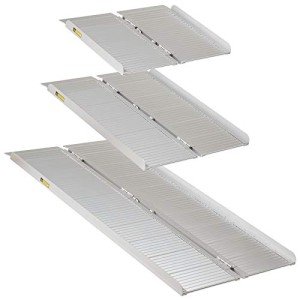
Temporary Wheelchair Ramp
Add a review FollowOverview
-
Founded Date April 15, 1922
-
Sectors Talent Management
-
Posted Jobs 0
-
Viewed 3
Company Description
See What Wheelchair Access Ramp Tricks The Celebs Are Making Use Of
Wheelchair Access Ramps: A Step Towards Inclusivity
In today’s world, availability has ended up being an essential aspect of guaranteeing everyone, despite physical ability, can browse environments quickly and independently. Among the essential parts for improving ease of access is the wheelchair access ramp. This article checks out the significance of wheelchair ramps, their style, policies, and provides some often asked concerns to help understand their significance.
The Importance of Wheelchair Access Ramps
Wheelchair ramps serve as a bridge for individuals with mobility difficulties, permitting them to access buildings, walkways, public transportation, and various locations without physical barriers. Here are some crucial reasons why wheelchair access ramps are necessary:
- Promote Inclusivity: Ramps enable individuals with specials needs to participate totally in social activities.
- Compliance with Regulations: Many countries have laws that need public buildings and spaces to be accessible.
- Improved Safety: Ramps reduce the danger of mishaps that may occur when navigating stairs or uneven surface areas.
- Enhanced Mobility: They offer convenient access for individuals utilizing wheelchairs, walkers, or other assistive gadgets.
Design Considerations for Wheelchair Ramps
When developing a wheelchair ramp, various elements require to be considered to ensure efficiency and safety. Below are some important design aspects:
| Design Element | Recommendation |
|---|---|
| Slope Ratio | A maximum slope of 1:12 (4.76 degrees) is recommended for ease of access. |
| Width | At least 36 inches broad for standard wheelchair access. |
| Surface Material | Non-slip products ought to be utilized to avoid mishaps, even in wet conditions. |
| Landings | Flat landings at the top and bottom of ramps should be at least 60 inches long. |
| Curbs | 2- to 4-inch curbs can assist avoid wheelchairs from rolling off the sides of the ramp. |
| Handrails | Hand rails need to be positioned at 34 to 38 inches in height on both sides of the ramp. |
Regulations and Standards
In the United States, the Americans with Disabilities Act (ADA) sets clear requirements for wheelchair ramps to ensure public ease of access. Comparable guidelines exist in other nations also. Here are some essential guidelines from the ADA concerning wheelchair ramps:
- Slope: A ramp should have an optimum rise of 30 inches for every 1 foot of ramp run.
- Width: Ramps must be at least 36 inches broad, although they can be wider for much better availability in high-traffic areas.
- Landings: Must be flat and a minimum of 60 inches in length for both the top and bottom of the ramp.
- Surfaces: The surface ought to be stable, firm, and slip-resistant.
- Handrails: Ramps that are more than 6 inches high ought to include hand rails.
Types of Wheelchair Ramps
There are various kinds of wheelchair ramps tailored for particular requirements and environments. Here are some typical types:
-
Permanent Ramps: These are built from materials such as concrete, wood, or metal and are created for long-term usage. They are often utilized in public buildings and homes.
-
Portable Ramps: Lightweight and simple to transport, portable ramps can be borrowed and are ideal for individuals who require a ramp for brief durations.
-
Folding Ramps: These ramps fold in the middle, making them simple to shop and transport. They are best for those who need access to numerous places.
-
Threshold Ramps: Used primarily for entrances, these ramps assist eliminate little vertical barriers. They are vital for homes and buildings where door limits provide a difficulty.

-
Modular Ramps: Made from premade sections that can be put together on-site, modular ramps can be tailored for specific building requirements and can operate in different settings.
Frequently Asked Question About Wheelchair Access Ramps
1. Who is accountable for installing wheelchair ramps?
The obligation for setting up wheelchair ramps can vary. In public areas, it is usually the duty of structure owners or towns to comply with availability policies. In domestic spaces, property owners are accountable for setup.
2. Exist monetary assistance programs for installing ramps?
Yes, there are numerous assistance programs, consisting of government funding and non-profit companies, that aid individuals pay for wheelchair ramp installations. It’s worth looking into local options.
3. How do I keep a wheelchair ramp?
Routinely check the ramp for cracks, extending nails, or loose surface areas. Keeping it tidy and devoid of particles or snow throughout winter season is necessary for ensuring safety.
4. Will a wheelchair ramp impact property worth?
While setting up a wheelchair ramp might not straight increase residential or commercial property worth, it can make a residential or commercial property more appealing to purchasers seeking accessibility options.
5. How can I find a qualified professional to set up a wheelchair ramp?
Start by searching for specialists who focus on accessibility building and construction. Check referrals, reviews, and reviews to ensure they have experience in structure compliant ramps.
Wheelchair access ramps are essential for enhancing ease of access and promoting inclusivity for people with mobility challenges. By sticking to create standards and regulations, these ramps can provide safe and easy access to structures and public areas. As society relocations towards greater inclusivity, the presence of wheelchair ramps functions as a testimony to our dedication to breaking down barriers and opening doors for everyone.
Whether as a small addition to a home or part of a larger public infrastructure project, these ramps represent a substantial stride towards a more available world for all.
